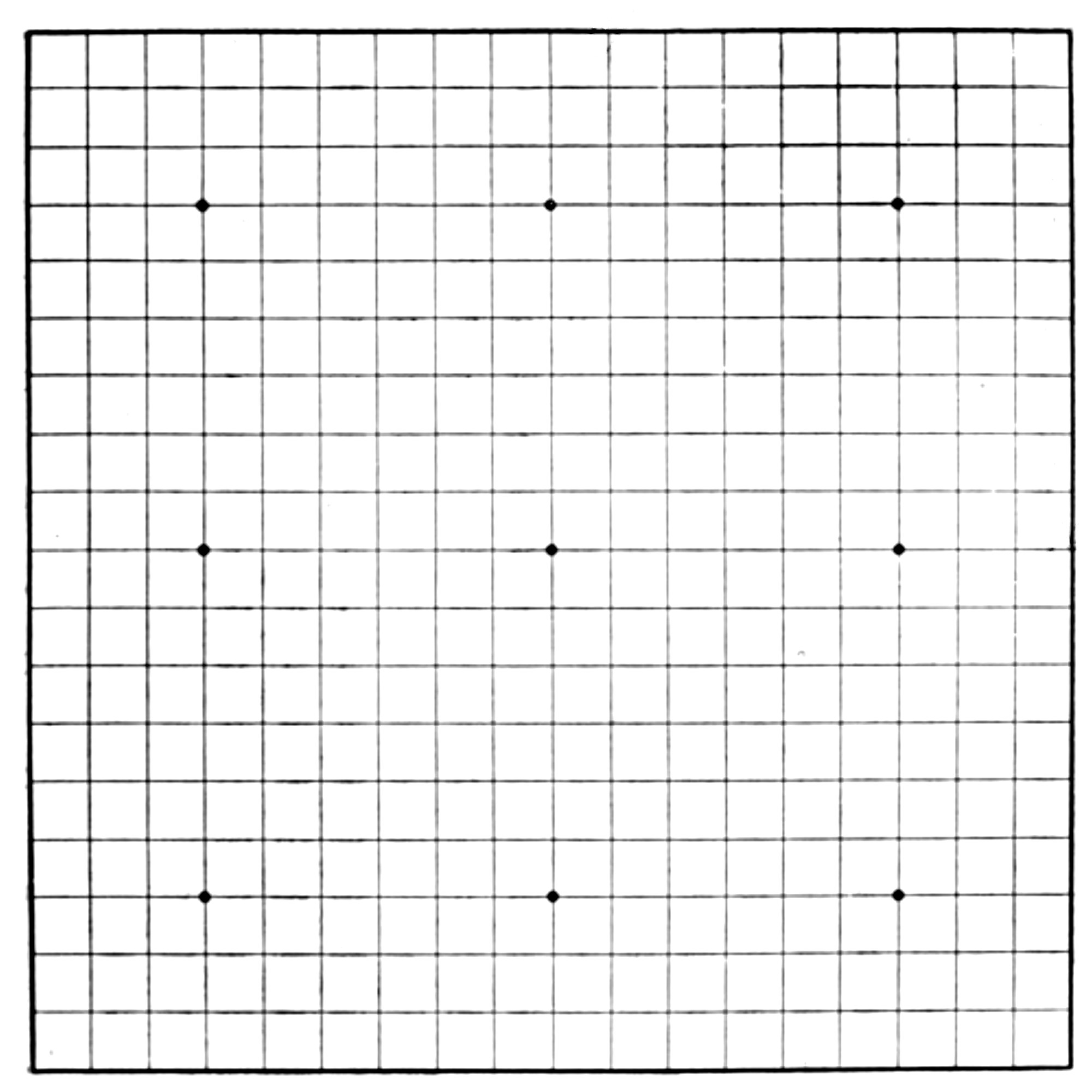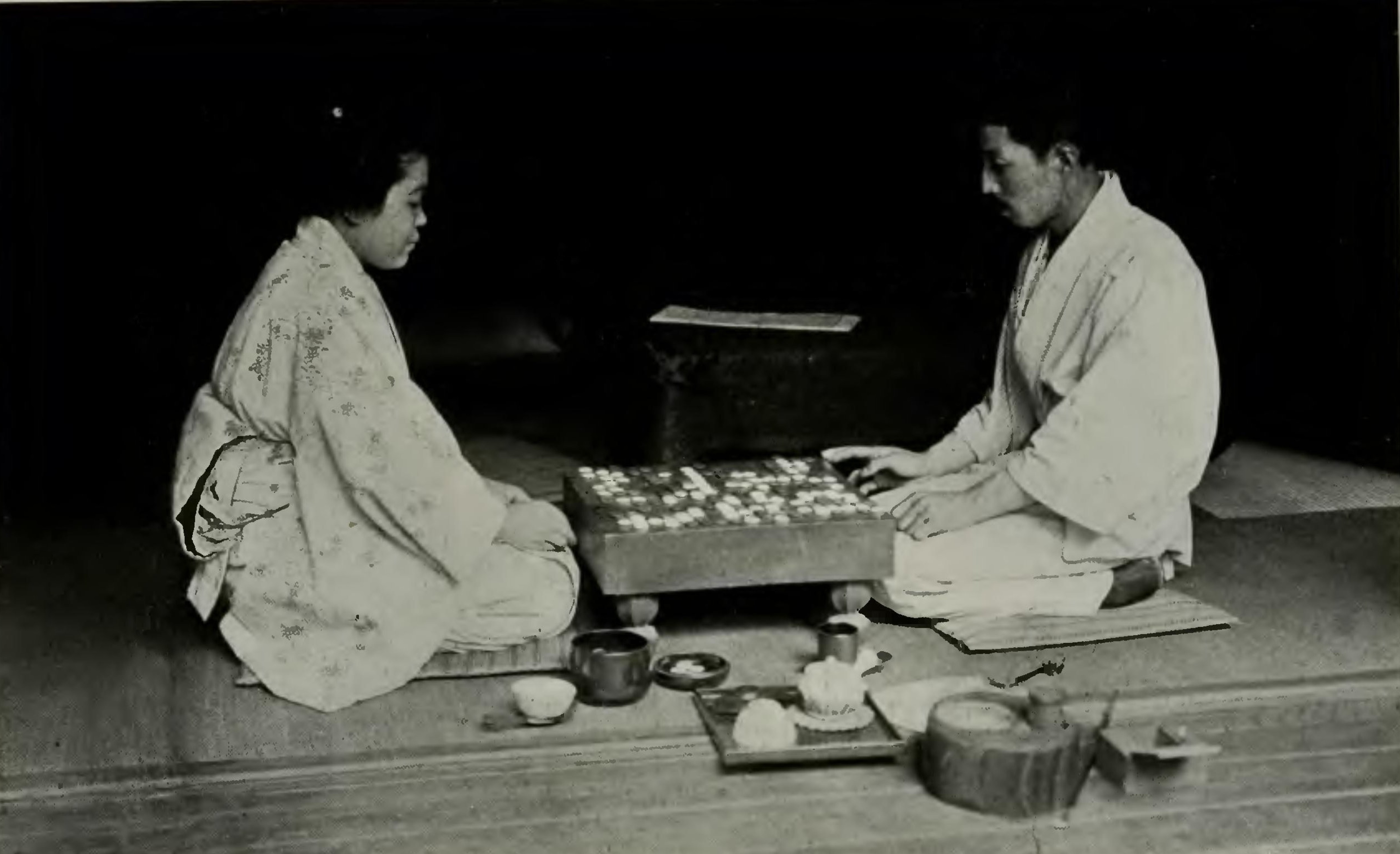| Web
and Book design,
Copyright, Kellscraft Studio 1999-2018 (Return to Web Text-ures) |
 (HOME)
|
| II DESCRIPTION OF THE BOARD AND STONES THE board, or
"Go Ban" as it is called in Japanese, is a solid block of wood, about
seventeen and a half inches long, sixteen inches broad, and generally
about
four or five inches thick. It has four detachable feet or legs so that
as it
stands on the floor it is about eight inches high. The board and feet
are
always stained yellow. The best boards in Japan are made of a
wood called "Kaya" (Torreya
Nucifera) a species of
yew. They are also made of a wood called
"Icho" or Gingko (Salisburia
adiantifolia) and of
"Hinoki" (Thuya Obtusa) a kind of cedar. At all events they must
be of hard wood, and yet not so
hard as to be unpleasant to the touch when the stone is placed on the
board,
and the wood must further have the quality of resonance, because the
Japanese
enjoy hearing the sound made by the stone as it is played, and they
always
place it on the board with considerable force when space will permit.
The
Japanese expression for playing Go, to wit, "Go wo utsu," literally
means to "strike" Go, referring to the impact of
the stone. In Korea this feature is carried to such an extreme that
wires are
stretched beneath the board, so that as a stone is played a distinct
musical
sound is produced. The best boards should, of course, be free from
knots, and
the grain should run diagonally across them. In the back of the board there is cut a
square depression. The purpose
of this is probably to make the block more resonant, although the old
Japanese
stories say that this depression was put there originally to receive
the blood
of the vanquished in case the excitement of the game led to a
sanguinary conflict. The legs of the board are said to be
shaped to resemble the fruit of the
plant called "Kuchinashi" or Cape Jessamine (Gardenia floribunda), the
name of which plant by
accident also
means "without a mouth," and this is supposed to suggest to onlookers
that they refrain from making comments on the game (a suggestion which
all
Chess players will appreciate). On the board, parallel with each edge, are
nineteen thin, lacquered
black lines. These lines are about four one-hundredths of an inch wide.
It has
been seen from the dimensions given that the board is not exactly
square, and
the field therefore is a parallelogram, the sides of which are sixteen
and a
half and fifteen inches long respectively, and the lines in one
direction are a
little bit farther apart than in the other. These lines, by their
crossing,
produce three hundred and sixty-one points of intersection, including
the
corners and the points along the edge of the field. The stones are placed on these points of
intersection, and not in the spaces
as the pieces are in Chess or Checkers. These intersections are called
"Me" or "Moku" in Japanese, which really means "an
eye." Inasmuch as the word as used in this connection is
untranslatable, I
shall hereafter refer to these points of intersection by their
Japanese name. On the board, as shown in the diagram
(Plate 1), are nine little
circles. It is on these circles that the handicap stones when given are
placed.
They have no other function in the game, but they are supposed also to
have some sort of symbolical meaning. Chamberlain states
that these
spots or "Seimoku" are supposed to represent the chief celestial
bodies, and that the central one is called "Taikyoku"; that is, the
primordial principle of the universe. In the work of Stewart Culin
referred to
in the preface it is stated that they correspond to the nine lights of
heaven —
the sun, moon and the seven stars of the constellation "Tau" (Ursa
Major). Indeed the whole arrangement of the board is said to have some
symbolical significance, the number of crosses (exclusive of the
central one)
representing the three hundred and sixty degrees of latitude, and the
number of
white and black stones corresponding to the number of days of the
year; but
nowadays the Japanese do not make much of a point of the astronomical
significance of the board or of the "Seimoku." The stones or "Ishi" with which the game
is played are three
hundred and sixty-one in number, corresponding to the number of "Me"
or points of intersection on the board. One hundred and eighty of these
stones
are white and the remaining one hundred and eighty-one are black. As
the weaker
player has the black stones and the first move, obviously the extra
stone must
be black. In practice the entire number of stones is never used, as at
the end
of the game there are always vacant spaces on the board. The Japanese
generally
keep these stones in gracefully shaped, lacquered boxes or "Go
tsubo." The white stones are made of a kind of
white shell; they are highly
polished, and are exceedingly pleasant to the touch. The best come from
the
provinces of Hitachi and Mikawa. The black are made of stone, generally
a kind
of slate that comes from the Nachi cataract in Kishiu. As they are used
they
become almost jet-black, and they are also pleasant to the touch, but
not so
much so as the white. A good set is quite dear, and cannot be purchased
under
several yen. The ideograph formerly used for "Go ishi" indicates that
originally they were made of wood, and not of stone, and the old
Chinese
ideograph shows that in that country they were wooden pieces painted
black and
white. The use of polished shell for the white stones was first
introduced in
the Ashikaga period. In form the stones are disk-shaped, but
not always exactly round, and
are convex on both surfaces, so that they tremble slightly when placed
on the
board. They are about three-quarters of an inch in diameter, and about
one-eighth of an inch in thickness. The white stones are generally a
trifle
larger than the black ones; for some strange reason those of both
colors are a
little bit wider than they should be in order to fit the board.
Korschelt
carefully measured the stones which he used, and found that the black
were
seventeen-sixteenths of the distance between the vertical lines on his
board,
and about eighteen-nineteenths of the distance between the horizontal
lines,
while the white stones were thirteen-twelfths of the distance between
the
vertical lines and thirty-six thirty-sevenths of the distance between
the
horizontal lines. I found about the same relation of size in the board
and
stones which I use. The result of this is that the stones do
not have quite room enough and
lap over each other, and when the board is very full, they push each
other out
of place. To make matters still worse the Japanese are not very careful
to put
the stones exactly on the points of intersection, but place them
carelessly, so
that the board has an irregular appearance. It is probable that the
unsymmetrical shape of the board and the irregularity of the size of
the stones
arise from the antipathy that the Japanese have to exact symmetry. At
any rate,
it is all calculated to break up the monotonous appearance which the
board
would have if the spaces were exactly square, and the stones were
exactly round
and fitted properly in their places. In Japan the board is placed on the floor,
and the players sit on the
floor also, facing each other, as shown in the illustration, and
generally the
narrower side of the board is placed so as to face the players. Since
the introduction
of tables in Japan Go boards are also made thinner and without feet,
but the
game seems to lose some of its charm when the customs of the old Japan
are
departed from. The Japanese always take the stone between
the middle and index fingers,
and not between the thumb and index finger as we are likely to do, and
they
place it on the board smartly and with great skill, so that it gives a
cheerful
sound, as before stated. For use in this country the board need not
be so thick, and need not, of
course, have feet, but if it is attempted to play the game on
cardboard, which
has a dead sound as the stones are played, it is surprising how much
the pleasure
of the game is diminished. The author has found that Casino chips are
the best
substitute for the Japanese stones.  PLATE 1. The Board Showing the "Seimoku."  Playing Go Originally the board used for the game of
Go was not so large, and the
intersecting lines in each direction were only seventeen in number. At
the time
of the foundation of the Go Academy this
was the size of board in use. As the game developed the present number
of lines
became fixed after trial and comparison with other possible sizes.
Korschelt
made certain experiments with the next possible larger size in which
the number
of lines in each direction was twenty-one, and it seemed that the game
could
still be played, although it made necessary the intellect of a past
master to
grasp the resulting combinations. If more than twenty-one lines are
used
Korschelt states that the -combinations are beyond the reach of the
human mind. In closing the description of the board it
may be interesting to point
out that the game which we call "Go Bang" or "Five in a
Row," is played on what is really a Japanese Go board, and the word
"Go Bang" is merely another phonetic imitation of the words by which
the Japanese designate their board. I have found, however, that the "Go
Bang" boards sold in the stores in this country are an imitation of the
original Japanese "Go ban," and have only seventeen lines, and are
therefore a little too small for the game as now played. The game which
we call
"Go Bang" also originated in Japan, and is well known and still
played there. They call it "Go Moku Narabe," which means to arrange
five "Me," the word "Go" in this case meaning
"five," and "Moku" being the alternative way of pronouncing
the ideograph for eye. "Go Moku Narabe" is often played by good Go
players, generally for relaxation, as it is a vastly simpler game than
Go, and
can be finished much more rapidly. It is not, however, to be despised,
as when
played by good players there is considerable chance for analysis, and
the play
often covers the entire board. |